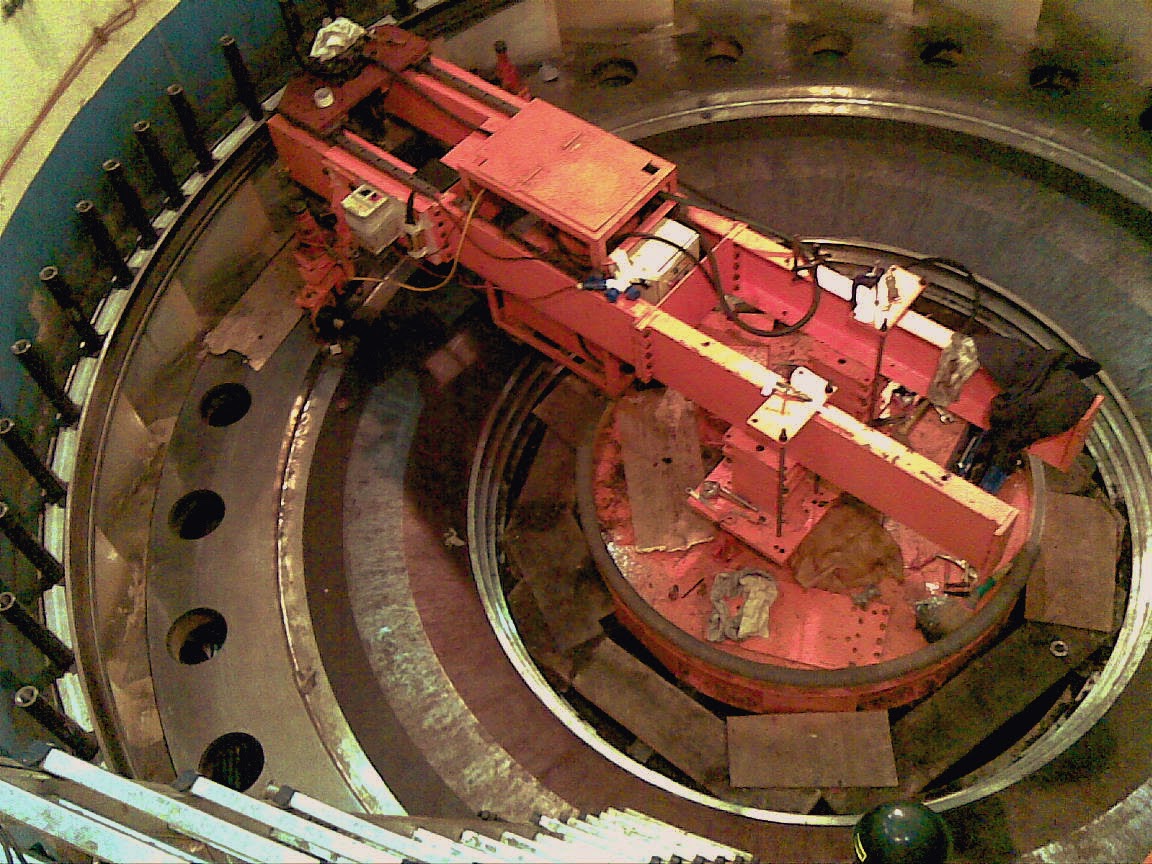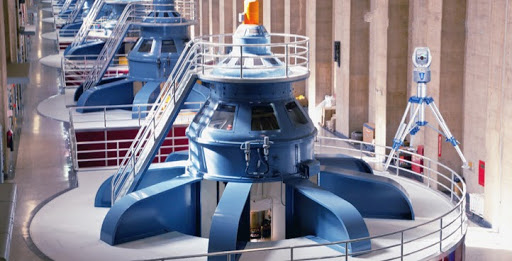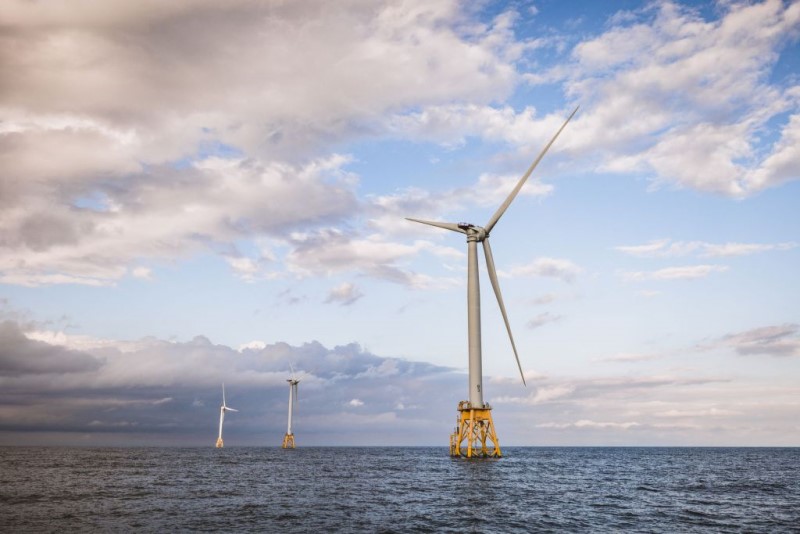Hydropower has been one of the earliest energy sources, originally harnessed to power industrial machinery before being adapted to generate electricity. Today, according to the International Energy Agency (IEA), hydropower is the world’s largest source of renewable energy, accounting for approximately 17% of global electricity production. As the world shifts towards renewable energy sources to meet the clean energy goals set by the 2015 Paris Agreement, hydropower plays a pivotal role in reducing carbon emissions and transitioning away from traditional fossil fuels.
Hydropower Equipment: The Need for Precision Maintenance
Like any large-scale production equipment, hydroelectric power generating units require precision maintenance to operate at optimal efficiency. Even the smallest deviations from OEM specifications can impact performance, leading to unplanned shutdowns, costly repairs, and downtime. Given the remoteness of many hydropower plants and the enormous size of components, on-site repair solutions are often the most efficient and cost-effective way to address equipment issues.
In-Situ Machining for Hydropower Components
In-situ machining offers a practical and precise solution to repair and maintain hydropower equipment without the need for disassembly or transportation of large components. By providing machining services directly at the hydropower plant, downtime is minimized, and repairs can be carried out efficiently to restore equipment to OEM standards.
Our in-situ machining services for the hydropower industry include:
- Machining of Wicket Gate Bushing:
Wicket gates control the flow of water to the turbine. Over time, wear and tear can lead to misalignment or damage in the wicket gate bushing. We offer precise in-situ machining to repair or rebuild these bushings to their original specifications, ensuring smooth operation. - Machining of Face Plates (Upper & Lower):
Face plates are critical to the structural integrity of hydroelectric turbines. Our in-situ machining solutions restore damaged face plates, ensuring they meet the tight tolerances required for optimal turbine performance. - Machining of Stay Ring and Wear Ring:
The stay ring and wear ring are essential for maintaining the efficiency and stability of the turbine. Our in-situ services include precise machining of these components to eliminate wear, prevent leaks, and ensure smooth, reliable operation. - Surveying and Dimensional Checks of Components:
Regular structural surveys and dimensional checks are critical for preventing unplanned shutdowns. We use advanced measurement tools to perform accurate dimensional checks of key components, ensuring that any misalignment or wear is addressed before it leads to operational issues.
Machining scope of Hydro Turbine refurblishment
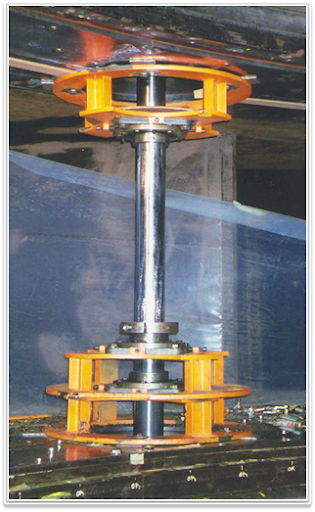
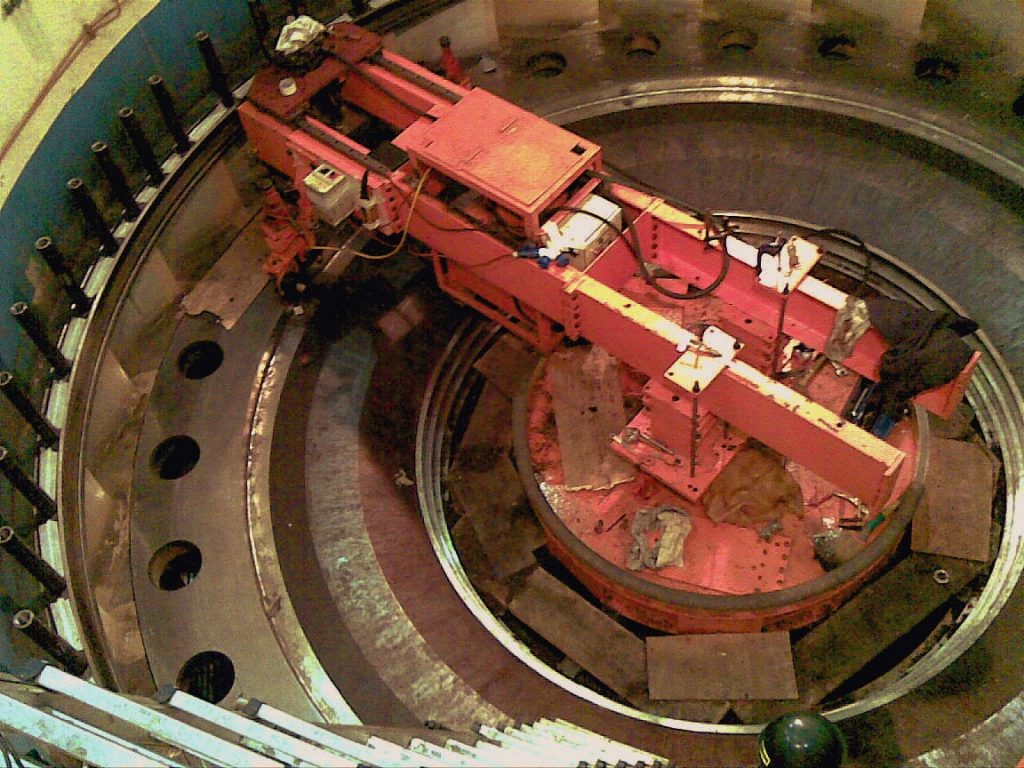
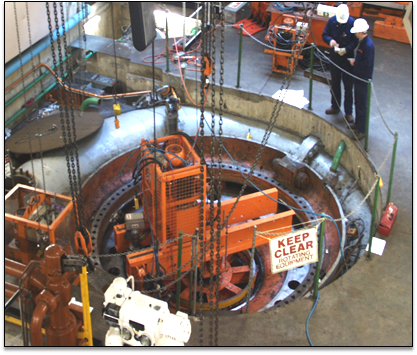
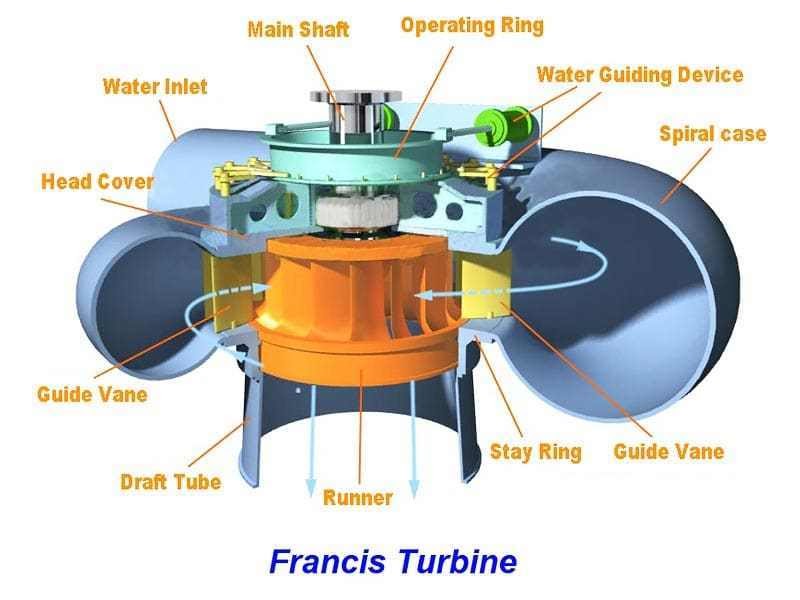
(1)
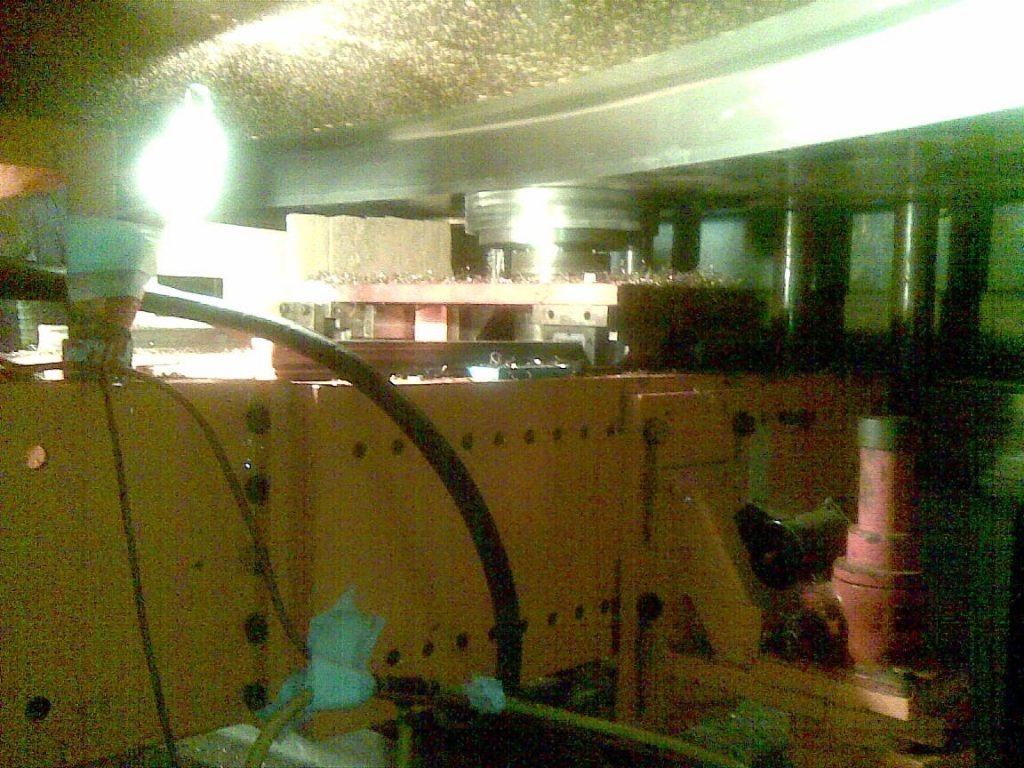
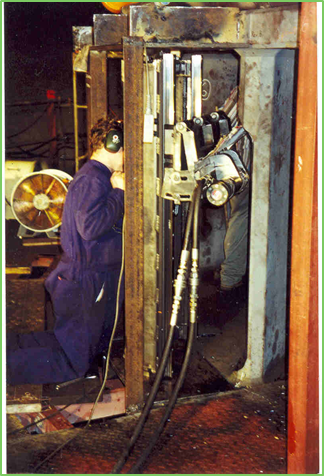
Wicket gates (also known as guide vanes) play a critical role in regulating the flow of water to hydroelectric turbines. These gates adjust the angle at which water strikes the turbine blades, thereby controlling the power output in response to load demands. Due to the swivel movement involved, the bushes supporting the wicket gates experience wear and must be replaced during regular turbine overhauls.
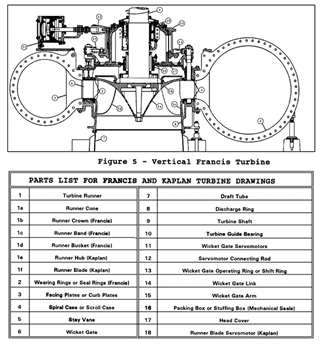
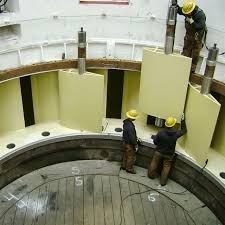
Wicket gates are integral components of Francis and Kaplan turbines, two of the most commonly used types of turbines in hydropower plants. As part of turbine overhaul programs, the removal and replacement of worn wicket gate bushes are essential to maintain optimal turbine performance and prevent operational issues.
During the overhaul, worn bushes are replaced with new bushes that have an undersized inner diameter. This allows for precision in-situ line boring, a process that ensures the bushes fit perfectly within the assembly and align with the other wicket gates.
The in-situ line boring process begins with setting up customized mounting brackets to hold the boring bars in place. These bars are then positioned at the required radial distance from the center of the turbine and aligned with the correct angular position relative to the other gates.
- Radial Distance and Chord Length Verification:
The accuracy of the setup is critical to the turbine’s operation. The radial distance from the unit’s center and the chord length between the 16 or 24 wicket gates are verified using precision tools such as a stick micrometer or laser tracker. This ensures there are no gaps between the wicket gate sealing surfaces and that the gates are perfectly perpendicular to the facing plates. - Boring Bar Setup:
The boring bar is carefully aligned and secured for the machining process. The goal is to achieve precise alignment, ensuring smooth movement of the wicket gates after the new bushes are installed.
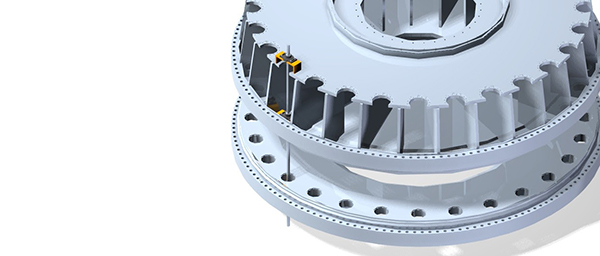
Before the machining process begins, it is crucial to inspect both the top and bottom facing plates for signs of wear, galling, or damage. The facing plates must be parallel to each other to prevent binding during wicket gate operation.
After inspecting the plates, the headcover is installed without the wicket gates, and the bolts are tightened to their full torque. This allows the level of the facing plates to be checked for plane accuracy and parallelism. While it’s important for the plates to be leveled true to earth, it is even more critical that they are parallel to each other and perpendicular to the wicket gate bushings. Misalignment can result in gate binding, leading to operational inefficiencies and increased wear on the components.
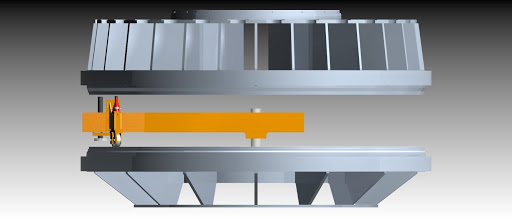
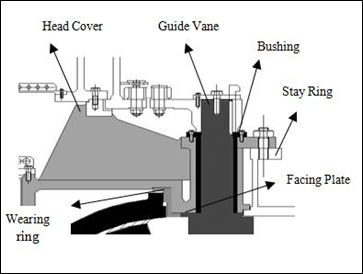
Accurate parallelism and levelness of the top and bottom plates in hydropower turbines, are critical for the smooth operation of the turbine and the long-term performance of the wicket gates.
Misalignment or unlevel surfaces can cause binding and wear, leading to decreased efficiency and potential breakdowns.
- Parallelism:
To ensure proper parallelism, the vertical distance between the top and bottom plates is measured at multiple points. This distance must be consistent and equal to the height of the wicket gates plus the recommended clearance between the gates and plates. Any variation in distance can indicate a misalignment that requires correction. - Levelness:
The levelness of the plates is typically checked using either a precision engineering level or a geometric laser device. These tools provide accurate measurements, ensuring that the plates are properly aligned and true to the horizontal plane.
If discrepancies in parallelism or levelness are found, in-situ machining can be used to restore the surfaces to their proper condition. Machining both the top and bottom plates ensures they are level and parallel, but this process can only be performed if there is sufficient material remaining on the plates.
- Machining Surfaces:
Our in-situ machining services are designed to restore parallelism and levelness by precisely machining the surfaces of the plates. This process eliminates imperfections and ensures the vertical distance between the plates is accurate and consistent.
In some cases, the plates may have worn down too much, leaving insufficient material for further machining. In such conditions, the best solution is to install new plates. These replacement plates are then machined in-situ to achieve perfect levelness and parallelism, compensating for any unlevelness in the existing structure.
Why In-Situ Machining is Key for Hydropower Maintenance
- Reduced Downtime:
By performing repairs directly on-site, in-situ machining minimizes downtime and allows for quicker turnaround times compared to transporting components to an off-site facility. - Precision Repairs:
In-situ line boring ensures that the new bushes fit perfectly within the assembly, preventing misalignment and ensuring smooth operation of the wicket gates. - Cost-Effective Solutions:
On-site machining eliminates the costs associated with dismantling, transportation, and reassembly, making it a highly cost-effective solution for hydropower maintenance.
3D Digital Survey for Hydropower Plant Maintenance and Alignment
Precision is key when maintaining and aligning components within hydropower units. Traditionally, tools like precision levels, tight wires, and plumb bobs have been used for alignment, but these methods are often time-consuming and susceptible to human error. With the rise of 3D digital surveying technologies, such as laser trackers and total stations, hydropower plants can achieve faster, more accurate alignment while gathering valuable digital records for predictive maintenance.
Advantages of 3D Digital Surveying for Hydropower Plants
- Increased Accuracy:
By using laser trackers, hydropower plant operators can precisely realign new equipment to its original position, capturing detailed 3D data files in the process. This level of precision ensures accurate measurements and long-term operational efficiency. - Reduced Human Error:
Conventional methods are more prone to human error, whereas digital survey tools minimize these risks by automating the alignment and measurement process. - Faster Setup and Analysis:
3D digital survey tools allow for quick setup and execution, reducing the time needed for alignment and inspections. This leads to decreased downtime during maintenance.
To further enhance the precision of the alignment process, we couple laser trackers, total stations, and FaroArm technology using Spatial Analyser software. This advanced setup allows for measurements in hard-to-reach areas and from multiple locations, even when direct line of sight isn’t possible. Common datum points are used for reference, enabling highly accurate alignment across large and complex assemblies.
Components for Dimensional Check and Alignment
3D digital surveying can be applied to numerous critical components within a hydropower unit. Regular dimensional checks on these components allow for the early identification of repair needs, preventing costly shutdowns and improving overall plant efficiency. Some of the components that can benefit from 3D digital surveys include:
- Head Casing Inspections & Alignment:
Ensuring the proper fit and positioning of the head casing, crucial for efficient turbine operations. - Wicket Gate, Stay Ring, and Discharge Ring Inspections:
Accurate alignment of these components is essential for maintaining water flow and turbine performance. - Runner Inspections:
Monitoring the runner’s condition and alignment to ensure optimal power generation. - Generator Alignment:
Ensuring key bars, stators, and main bearings are correctly aligned to avoid vibration and wear on the generator components. - Horizontal Machine Bearings Alignment:
Ensuring bearings are perfectly aligned for smooth rotation and minimal friction. - Main Shaft Inspection and Alignment:
Ensuring the shaft is straight and properly aligned to reduce stress on rotating parts. - Case-to-Case Alignment (With or Without Rotating Assemblies):
Ensuring the proper fit and alignment of turbine cases, either with or without the rotating equipment in place. - Installation Pads Alignment & Verification:
Confirming that installation pads are properly aligned for the stable operation of the entire unit.
Why Choose 3D Digital Surveying?
- Data-Driven Predictive Maintenance:
With accurate digital records and 3D data files, hydropower plants can implement predictive maintenance strategies. This helps identify issues before they lead to failure, reducing unplanned outages and repair costs. - Comprehensive Documentation:
The digital records created during 3D surveys provide valuable documentation for future reference, making it easier to track wear patterns, plan maintenance, and realign equipment as needed. - Time and Cost Efficiency:
The ability to quickly and accurately measure, align, and inspect components without needing to dismantle large parts saves time and reduces costs associated with downtime.
By embracing 3D digital surveying technology, hydropower plants can significantly enhance the precision and efficiency of their maintenance and alignment processes. Laser trackers, total stations, and FaroArm technology offer superior accuracy, faster results, and comprehensive digital records that support long-term operational efficiency. Contact us today to learn more about how our 3D digital survey solutions can improve the performance and reliability of your hydropower plant.



